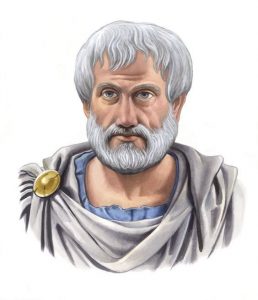TROUBLE FOLLOWS ME
Part Three

Aristotle
“A tragedy is a representation of an action that is whole and complete and of a certain magnitude. A whole is what has a beginning and middle and end.”
–Aristotle, The Poetics

Ted Baxter
“It all stated at a little 5,000-watt station in Fresno, California.”
—-Ted Baxter, The Mary Tyler Moore Show
A SPRAWLING MYSTERY NOVEL
Ross Macdonald was the beneficiary of a literary education at a time when that implied a careful study of classical literature, and his body of work (most obviously The Three Roads shows that he had a deep understanding of Greek literature. It is not known whether Macdonald was taught that the Aristotelian unity of time, place and action was a Renaissance invention, but Macdonald was exposed to more than enough Classical thinking to profoundly influence his work.
As his work matures, he increasingly demonstrates his understanding for the need for unity in a way Aristotle would have understood. By his late work (Sleeping Beauty comes to mind as an example) the entire novel is essentially one continuous account of the actions of Lew Archer. But his tale in Trouble Follows Me does not fit neatly into the Classical ideal:
- It starts in Oahu
- Moves to the slums of Detroit (Oahu is nicer)
- Takes a transcontinental train ride and
- Ends in Mexico.
Time intervals of varying lengths separate all but the third and fourth locations. Macdonald formally divides his book into four parts corresponding with the four locations, a device he does not use again, although he does formally divide The Three Roads into four day sections.
Part I How I Spent My Oahu Vacation
Just the Facts, Ma’am
Macdonald has yet to display a gift for the snappy opening sentence, but his opening chapter presents all the facts necessary to present the initial mystery:
- Our narrator-hero is a US Navy ensign, Sam Drake, on survivor’s leave after the sinking of his ship, awaiting transportation to the mainland.
- Drake is with a friend, a fellow-officer, Eric Swann, at a large private club called the Honolulu House, which tries to appear as a responsible place but is an after-hours bar. Drake and Swann have known each other for some time and are both originally from Detroit. Unlike Drake, Swann has a wife back home, Helen.
- Swann has brought along his girlfriend to meet Drake, a petite woman named Sue Sholto. Sue is unabashedly Jewish and liberal.
- The fourth member of what turns into a sort of double date is Mary Thompson, tall, glamourous, and slightly mysterious. Mary and Sue know each other, both being employed as disc jockeys at a Honolulu radio station.
- The party is joined by a local journalist, Gene Halford, a war correspondent, whose role is to introduce the possibility that Japanese spies are receiving information about ship movements from Hawaii, but no one can figure out how. Hold that thought.
- The evening is rounded off by Mrs. Merriwell, a woman of a certain age and social position who after some pleasantries reveals that she is an unreconstructed racist. For the rest of the chapter, her racist views are the subject of ridicule by Sue Sholto.
- Drake and Mary Thompson begin what some would describe as tepid flirting and what Macdonald probably considered to be blatant sexual repartee.
- Sue goes upstairs to use the ladies’ room and disappears. A few minutes later she is discovered dead, hanging by a noose out an upper story window.
Some Evaluation
- Drake is a less objectionable version of Robert Branch from The Dark Tunnel, but he is still silly enough to deliver lines like, “I’m an intellectual among roughnecks and a roughneck among intellectuals.” It will take some straight talk from his wife Margaret before Ross learns to put a sock over such nonsense.
- I am not enthusiastic about guessing the reasons behind the naming of characters, but because swans are rumored to mate for life, an adulterous husband named “Swann” is just too good to pass up. Swann will be presented as a weak and unattractive character throughout the book. Macdonald was famously intolerant in real life of marital infidelity. Years later, when his closest friend finally left a thoroughly miserable marriage and found lasting happiness with his new wife, Macdonald never spoke to them again. Given the miserable nature of Macdonald’s own marriage we can only speculate on the reasons for his vehemence.
- It took moral courage to create the Sue Sholto character in 1945. To have a Jew assertive about her identity, to challenge established racial prejudice, and to be a woman, Macdonald was pressing every button he could lay his hands on. We forget that anti-Semitism was alive and well during the war. Roosevelt made a calculated decision not to mention the Nazi death camps for fear of offending Polish voters and of making the war appear to be a crusade on behalf of the Jews. The first serious cultural attack on anti-Semitism, Laura Hobson’s Gentleman’s Agreement, would not appear until 1947 and when it did, it was highly controversial.
- Early Macdonald at his best; “Sue Sholto appeared at the foot of the stairs and came across the room towards us. The movements of her small perfect body were birdlike and precise. I had the impression that she came back to Eric like a hawk to a wrist.”
- The scenes at Honolulu House are well-done and well-described. Macdonald’s wartime visits to Pearl Harbor gave him the raw material for a vivid and convincing portrait.
- The first chapter is a model of economy. In 23 pages we meet (or at least see references to) most of the important characters of the book, the main themes have been identified, and we have our first murder. Not bad for a young ensign scribbling on a desk in the bowels of a warship in the middle of a war.
Recent Comments